
Original Link: https://www.anandtech.com/show/202
| The self proclaimed microprocessing giant, Intel, has managed to hold spheres of influence in just about any facet of the PC Hardware World one could imagine. Previously concentrating on Chipsets and Microprocessors, Intel managed to leave a major portion of the PC market uncharted, the Graphics Industry. During the aftermath of the release of 3Dfx Interactive's Voodoo2 chipset and building on the success of the outstanding 2D/3D combination nVidia's Riva 128 dazzled users with, Intel managed to release their own graphics chipset: the i740. | 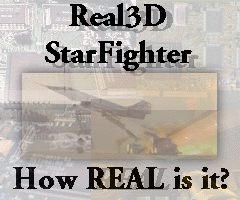 |
Sounding much like an overpriced luxury automobile, the i740 chipset is the heart of the latest graphics accelerator from Real3D. A company that helped develop and perfect the i740 design, naturally you would expect their i740 card, the StarFighter - named after the Lockheed Martin F-104 StarFighter aircraft - to be the flagship for the chipset...which brings us to the question: how Real is the Real3D StarFighter? Let's find out.
3D Hardware Features
- Real-time video texturing
- 16-bit color, double buffering, and Z-buffer
- Bilinear and Trilinear MIP mapping
- Perspective corrected texture
- Flat, Gouraud, and specular shading
- Alpha blending and fog
- Anti-aliasing and dithering
- Stipple, "screen door", transparency
- Strips and fans (PCI)
- Backface culling
- Texture color or chroma keying
- Stretch and transparent bits
3D Graphics Performance
- 1.35M 3D polygons/second
- 1.5M 3D vectors/second
- 66M pixels/second
Video Features
- MPEG-2/DVD at 30 frames per second
- Scaling and interpolation
- YUV-RGB conversion
- Gamma corrected video
- Chroma keying
- NTSC/PAL input (option)
- Video capture (option)
- NTSC/PAL output (option)
Supported Display Modes
Real3D StarFighter |
|||
| Colors | Refresh Rate | ||
Resolution |
2D | 3D | (Hz) |
| 1600x1200 | 256 | 256 | 70-75 |
| 1280x1024 | 64K | 16M | 70-85 |
| 1024x768 | 64K | 16M | 70-85 |
| 800x600 | 64K | 16M | 70-85 |
| 640x480 | 64K | 16M | 70-85 |
Other Features
- Frame buffer: 4MB SGRAM (8MB optional on AGP)
- Texture buffer (PCI only): 0, 8, or 16MB SDRAM
- DDC-2B
- Multiple monitor support
System Requirements
- StarFighter AGP: Pentium II processor-based motherboard with one AGP slot (1X or 2X)
- StarFighter PCI: Pentium or Pentium II processor-based motherboard with one PCI slot (PCI v2.1 compatible)
Supported Operating Systems
- Microsoft Windows (95 or higher)
- Microsoft Windows NT (4.0 or higher)
Supported Graphics APIs
- Direct3D
- OpenGL
Service and Support
- Direct, toll free Real 3D support line: 1-888-832-4733
- Internet web site for access to driver updates and technical support
Warranty
- Three years (parts and labor)
With a company like Intel it is obvious that the i740 would have to pack a major punch, and it is clear that it does. Giving the ATI Xpert@Work some competition, the Real3D StarFighter is the second video card out on the market that supports AGP 2X mode, it is because of the i740's support for AGP 2X that Real3D could remove all texture memory off the StarFighter. Instead of searching the StarFighter for textures stored in the limited local memory of the video card, a 3D game or application will use the Accelerated Graphics Port as a means of retrieving the textures from System Memory, meaning much larger textures can be easily handled and manipulated without even the slightest twitch by the chipset.
| The StarFighter reviewed here was an AGP card, sporting 4MB of onboard SGRAM with an optional 4MB SO-DIMM (Small Outline Dual Inline Memory Module) for a total of a possible 8MB Frame Buffer on the card. Real3D will also release PCI versions of the StarFighter, using their proprietary PCI to AGP bridge, the PCI card will act much like the AGP StarFighter in that it will fool programs into thinking that it is an AGP card while retrieving textures from the Local Texture Memory present on the card. As long as your programs don't exceed the texture memory allocated to the card (8MB or 16MB depending on which card you buy) you will receive AGP-like performance. | 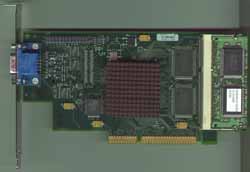 |
| It is because of this technology, coupled with
the ability to transfer on the sidebands of the AGP Bus allow the StarFighter to run in
resolutions up to 1280 x 1024 in both 2D and 3D situations. Even 12MB Voodoo2
cards are limited to a maximum of 800 x 600 in Quake 2 (GL), in comparison, a 4MB
StarFighter AGP can run at 1024 x 768 without the use of any external RAM add-ons. Real3D chose to include a standard SO-DIMM expansion socket on the StarFighter as mentioned above, unfortunately the card tested by Anand Tech didn't feature any of the extra perks the i740 chipset supports, such as TV-Output. The i740 processor itself remains hidden by the massive heatsink on the StarFighter, during normal operation the heatsink is warm to the touch, however it is nothing you should worry about. A Voodoo2 card can easily generate in excess of twice as much heat in the same system. |
|
One of the most notable features of the StarFighter AGP has nothing to do with the speed of the chipset, or the construction of the card, rather the first class software bundle Real3D provides with this card. The software bundle includes special demo versions of Criterion RedLine Racer, Sega's Daytona USA, Moto Racer, Andretti Racing, trueSpace, as well as Incoming and Wing Commander Prophecy to name a few.
Out of the box, it becomes apparent that Real3D went to a lot of trouble to ensure that your first experience with the i740 graphics chipset would be a positive one. Unfortunately, the three attractive CD-ROM's packaged with the StarFighter weren't enough to remove all of the hassles of installing this card.
Under Windows NT 4.0, the main requirement that must be met is that you need to have Service Pack 3 Installed. NT4 Service Pack 3 can be obtained from Microsoft's site or if you happen to be one of the lucky few that got an Internet Explorer 4.0 CD with Windows NT4, you can find Service Pack 3 on that CD-ROM as well. A quick reboot after the StarFighter AGP drivers were installed gave Windows NT the "ok" to bring up the Display Properties Window which allowed the test system's [2D] resolution to be set at 1024 x 768 x 16-bit color. At that color depth the highest achievable resolution was a disappointment at 1280 x 1024, for those of you with 21"+ monitors you may be out of luck for now, unless Real3D can address this issue in a later revision of the drivers. Quake 2 easily ran under Windows NT 4.0, under the Video menu the "default OpenGL" driver was selected, revealing the outstanding image quality of the i740...and making way for some impressive performance.
Windows 95 was where the large portions of the StarFighter's installation process were met with frustration. First of all, you simply must have Windows 95 Service Release 2.0 installed. Furthermore, the drivers will not install on any version of Windows 95 prior to Service Release 2.1. If you happen to have Windows 95 Service Release 1, you can download most of the Service Release 2 components off of Microsoft.com, however upgrading from OSR2.0 to OSR2.1 is a more picky process. The only difference between 2.0 and 2.1 is the presence of the USB Supplement Patch in OSR2.1, this patch can be obtained by searching for the string 'USBSUP' using FTPSearch. To find out which version of Windows 95 you have, check the System Control Panel (Start>Settings>Control Panel>System) and look at the Windows 95 version number under the heading System. If it reads 4.00.950 A, then you have the original release of Windows 95, if it reads 4.00.950 B then you have the Service Release 2 and probably just need to upgrade to 2.1 using the USB Supplementary Patch.
Even after patching the test system, the StarFighter AGP would not install properly, it caused a resource conflict with the PCI to PCI Bridge of the AOpen AX6L Test Motherboard...then later it caused a conflict with the System Board PnP BIOS Extension, the easiest way to resolve these two conflicts was to perform another clean format of the hard drive and install everything from scratch. The procedure for installing software is also a bit tricky with the StarFighter, first the OS must be installed, then any/all patches necessary for normal operation of the StarFighter, next Direct X 5.0 (155 or later - included on the StarFighter Drivers CD-ROM) and then the StarFighter AGP drivers. Currently the StarFighter AGP is only officially supported on Pentium II systems, however Real3D is currently working for non-Intel chipset drivers for VP3, MVP3, Aladdin V, SiS 5591, etc.. boards.
Real3D included an excellent set of Direct X 5.0 drivers for the StarFighter AGP, in addition to an OpenGL - D3D Wrapper on the Drivers CD-ROM. An OpenGL ICD (Installable Client Driver) is currently in the works for Windows 95, and it will shortly make its debut...hopefully boosting performance and image quality with OpenGL applications running under Windows 95. The Direct X drivers Real3D chose to include are very close to the final candidate of the drivers, so performance in that area doesn't have much room to be expanded.
| After installing the StarFighter AGP drivers, the rest of the setup procedure went without a hitch. Three new tabs appeared in the Windows 95 Display Properties Control Panel, much like 3Dfx's excellent configuration utility, the Real3D drivers allow the user to tweak the StarFighter AGP to the max. The Cockpit configuration utility Real3D includes with the Starfighter card makes installing the three CD's worth of additional software a much easier task, not to mention the simplified configuration process. The most difficult part to the StarFighter's setup is the initial installation of the card, if you can get past that step then the rest of the way is easy riding. | 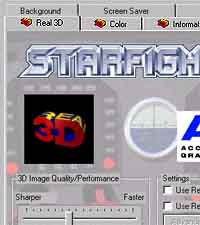 |
| The 220MHz RAMDAC present on the StarFighter AGP provides for realistic and sharp images under Windows, the 1280 x 1024 x 24-bit color current resolution limit of the card may prevent some owners of 21"+ monitors from enjoying their visual experience completely, however the sharp image quality of the card almost completely makes up for it. | |
In 3D situations the supported resolutions shouldn't be much of a problem, achieving 640 x 480 isn't a difficult task at all. Making full use of the AGP 2X Specification, the StarFighter AGP manages to really make a difference in your Desktop Video experience. The i740 will definitely raise the standards for Desktop 3D Acceleration, no longer will manufacturers be able to ride on the ability to run Quake 2 smoothly at 640 x 480 with their boards. With the release of the Voodoo2 it became clear that the 640 x 480 resolution was finally on its way out for games, being replaced by 800 x 600, easily achievable on the Voodoo2.
It should be noted that although the i740 is a great chipset, it isn't nor was it intended to be a Voodoo-killer. The image quality and performance (courtesy of features such as per pixel mip-mapping and full AGP support) are beyond that of the original Voodoo chipset, and give the Riva 128 a good run for the money, however the Voodoo2 remains the king of the 3D world by a considerable margin.
As mentioned before, the StarFighter will be available with TV-Out features later on, unfortunately the AGP version tested here lacked all TV-Out/DVD Interface features. Real3D paid great attention to detail with the StarFighter AGP, and their talents are quite apparent in their product. The card is also packaged with a cool looking Desktop Bitmap Background as well as an animated Busy Cursor to put a smile on your face, knowing that a company would go to these great lengths to please their customers is truly heat-warming in this industry.
Enough about the card, let's get to some real world tests and image quality comparisons shall we?
Click on the thumbnails to enlarge
Quake 2 - OpenGL Image Comparison |
||
| i740 - StarFighter AGP | Voodoo2 - Creative Labs | |
| Shot #: | ||
| Screen 1: | 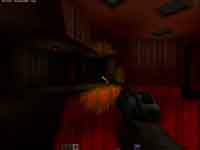 |
 |
| Screen 2: | 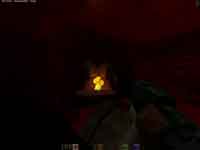 |
 |
| Screen 3: | 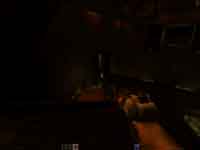 |
 |
| Screen 4: | 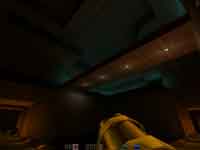 |
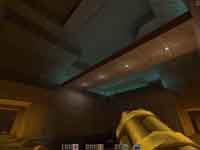 |
Compared to the Voodoo2 there is very little room for improvement with the i740's image quality. As you can tell by the above Image Quality Comparison, the i740 wipes the floor with the competition in terms of quality, the only difference between thhe i740 and the Voodoo2 screen shots from above is the difference in gamma adjustments between the two boards. Other than that, Voodoo2 owners should be expriencing much more than i740 users, and plus, with the Real3D StarFighter you gain above average 2D Performance as well as this sharp image quality.
Test Configuration |
|
| Processor/MB: | Intel Pentium II - 300 AOpen AX6L |
| RAM: | 1 - 64MB Corsair PC100 SDRAM DIMM |
| Hard Drive(s): | 2 - Western Digital Caviar AC21600H |
| Video Card(s): | Real3D StarFighter (4MB - AGP) Matrox Millennium II (4MB WRAM - AGP) |
| Bus Master Drivers: | Intel 3.01 |
| Video Drivers: | Real3D StarFighter AGP Drivers MGA Millennium 4.03.00.3410 |
| OpenGL Drivers: | Windows 95 Direct 3D Wrapper for OpenGL Windows NT Default OpenGL Drivers |
| Operation System(s): | Windows 95 Service Release 2.1 |
Ziff Davis Winbench 98 - 2D Performance |
||||
| Business | High End | |||
| Windows NT | Windows 95 | Windows NT | Windows 95 | |
| StarFighter 4MB | 146 | 142 | 141 | 146 |
| StarFighter 8MB | 152 | 147 | 154 | 145 |
| Millennium II 4MB | 175 | 175 | 184 | 172 |
Under Windows 95 the 2D performance of the Real3D StarFighter is a just about on par with the Matrox Millennium II, however under NT the Millennium II simply takes over with outstanding 2D performance, unmatched, by the StarFighter AGP. Under NT4, the extra 4MB of RAM with the 8MB card doesn't really seem to make a major difference, under Windows 95 the performance increase with the 8MB card over the 4MB is negligible as well. Since the AGP card doesn't have any texture memory, you are better off buying the 4MB card and saving yourself a few bucks, since the supported 3D resolutions won't be derived from (for the most part) your card and therefore limited by the local graphics memory.
In any case, the i740 was designed to be an outstanding 3D accelerator, which it is, unfortunately, the 2D performance is a sacrifice you will have to make if you want the full benefits of that AGP slot on your motherboard. The StarFighter isn't "bad" when it comes to 2D acceleration, it just can't compete with the Millennium II, it will still get the job done and then some.
Quake 2 - Open GL Performance |
||||
| Timedemo Demo 1 | Timedemo Demo 2 | |||
| Windows NT | Windows 95 | Windows NT | Windows 95 | |
| StarFighter 4MB 640 x 480 | 30.6 | 26.7 | 30.9 | 25.9 |
| CL Voodoo2 12MB 640 x 480 |
--- | 65.6 | --- | 64.0 |
| StarFighter 4MB 800 x 600 | 21.2 | 20.8 | 21.7 | 20.9 |
| CL Voodoo2 12MB 800 x 600 |
--- | 48.4 | --- | 48.9 |
Proving the point that there is no replacement for a Voodoo2 just yet, the Real3D StarFighter places well below the Creative Labs V2 board in all tests. Not to say that Quake 2 isn't playable on the StarFighter, in fact, Quake 2 looks and performs wonderfully at 800 x 600 on the StarFighter, not to mention how well the card works at its standard 640 x 480 resolution. If you're tight on PCI slots, and want to get the best of both the 2D and 3D world then the StarFighter becomes a much more appetizing option.
Direct 3D Performance |
||
| Frame Rate (higher is better) | ||
| Turok (Full Version) | Forsaken (Playable Demo) | |
| StarFighter 4MB 640 x 480 | 72.2 | 52.11 |
| CL Voodoo2 12MB 640 x 480 | 94.4 | --- |
| StarFighter 4MB 800 x 600 | --- | 40.73 |
| StarFighter 4MB 1024 x 768 | N/A | 28.9 |
The StarFighter's Direct3D performance is beyond decent especially when taking into consideration that the i740 can do this and much more. Still noticeably far behind the Voodoo2 in terms of performance, the StarFighter i740 card does remain competitive. The Forsaken Playable Demo (a beautiful game) produced frame rates in excess of 50 fps at 640 x 480, as well as a playable 25 - 30 fps at 1024 x 768, a resolution that does the game justice.
This is all coming from a meager 4/8MB card, confined to an AGP world that knows no limits.
Conclusion
For those of you that want the absolute best 2D/3D Combination, try using a Voodoo2 and a Millennium II, however that combo itself will set you back around $350 - $400, a price tag most users are not willing to swallow. Real3D has come along with an average priced product, that offers top notch image quality, while not sacrificing performance to a noticeable degree.
A custom made Real3D Direct3D wrapper was used to run Quake 2 under Windows 95, unfortunately there is some loss of performance/image quality with this wrapper. Once Real3D releases a reliable OpenGL ICD for the StarFighter, this card may begin to give the Riva 128's in the world a good scare in the Windows 95 market...as it has already done so under Windows NT as well as Direct 3D applications.







